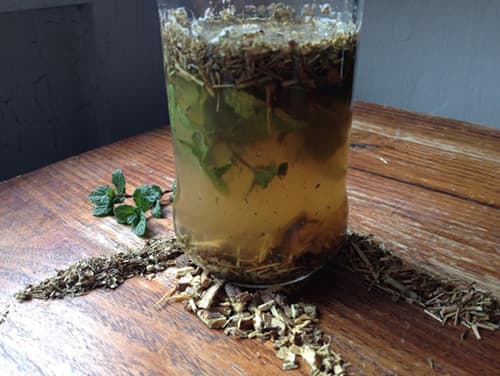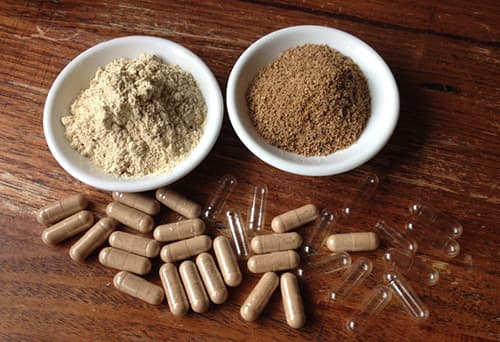
Better Than Sleeping Pills
Pills, teas, and tinctures are all great methods of utilizing plants as sleeping aids and there is even the potential to grow your own ingredients (depending on your climate of course). Choosing which method will depend on which plants you use, how much you take, and your own personal preferences.
Tea is hands-down the easiest way to prepare a homemade sleeping aid. You can use either fresh or dried plant matter. This method is particularly good for when higher doses are required (1 – 2 teaspoons), but it means that only the water-soluble compounds will be ingested.
Making your own sleeping pill is as simple as harvesting, drying then grinding them up so that you can fill up some capsules for a convenient, homemade supply. An herb grinder is an easy way to finely grind up dried plant matter, otherwise, a mortar and pestle and some elbow grease will have to do. When combining powdered herbs, be sure to thoroughly mix everything together. Pills are suitable for low-dose herbs (less than 1 gram per night) and since the whole plant is ingested, a wider variety of compounds are present in the pill form. Tinctures are suitable for a wide range of plants (fresh or dry) and can be made with either alcohol or vinegar. A tincture takes 1 – 2 weeks to prepare, but again, it contains a greater variety of compounds and at a higher concentration compared to a simple tea. It also potentially reduces your water intake before bedtime, since only a teaspoon or two are required.
Tinctures are suitable for a wide range of plants (fresh or dry) and can be made with either alcohol or vinegar. A tincture takes 1 – 2 weeks to prepare, but again, it contains a greater variety of compounds and at a higher concentration compared to a simple tea. It also potentially reduces your water intake before bedtime, since only a teaspoon or two are required.
Why Choose a Natural Remedy?
While there’s no guarantee that herbal remedies won’t have any negative reactions, prescription and over-the-counter drugs commonly used for insomnia tend to produce a wider range of side effects including stomach issues, daytime drowsiness, heart problems and withdrawal symptoms, just to name a few.
When it comes to natural remedies for improving sleep, some of the results are a bit all over the place. Much of this is to do with the lack of standardized research and methodology, and often the sample size is too small to draw any strong conclusions.
But some scientific reviews comparing the effects of plant-based remedies with those of over-the-counter medications found similar outcomes, but warn, as always, that more research is needed.
Plants Suitable For A Sleeping Tincture
- Hop flowers (Humulus lupulus) are proven sedatives, especially when taken with valerian. Either take 300 – 500 mg in pill form, 1 teaspoon of tincture, or 2 teaspoons of dried flowers in a tea.
- Valerian root (Valeriana officinalis) also has mixed outcomes, even compared to diazepam. But most reviews concluded that valerian could be a safe sleeping aid due to its sedative effects, but usually only after 2 weeks of usage. In pill form, take 600 mg but if combining it with hops or lemon balm then only 300 mg is necessary. As a tincture, only a teaspoon is needed.
- Lemon balm (Melissa officinalis) was found to decrease sleep disturbances when taken for as little as 2 weeks, but it is safe to take for up to 8 weeks. It is easiest taken as a tea (2 teaspoons) but for higher doses, a teaspoon of tincture is recommended.
- Passionflower (Passiflora incarnata) shows promising results for improving sleep quality and duration. You can take it as a tea at low doses (1 g) or as a tincture in higher doses (1 – 2 teaspoons). When combined with hop flowers and valerian, it was comparable with the insomnia drug Zolpidem.
- Pansy (Viola spp.) has a tranquilizing effect similar to Diazepam and increases sleep duration, but most of the research (performed on mice) showed that the effect is only significant at very high doses; the equivalent of about 3 teaspoons, so it is best concentrated into a teaspoon of the tincture.
Ingredients
Note: Don’t stress if don’t have some of the herbs listed below, the key is to have twice as much alcohol as herbs (i.e 5 oz of herbs soaked in 10 oz of alcohol).
- 0.9 oz (25 g) of hop flowers
- 0.7 oz (50g) of valerian root
- 0.9 oz (25g) of lemon balm
- 0.9 oz (25g) of passionflower
- 0.9 oz (25g) of pansy
- 10.5 oz (300 ml) of at least 80 proof/40% alcohol, or vinegar

DIY Tincture to aid sleeping: Place all of the ingredients in a sterilized jar ensuring all of the plant matter stays submerged by the alcohol (or vinegar). FYI: fresh herbs are easier to keep submerged. Place in the fridge for 1 – 2 weeks, shaking every day. Strain and store in a dark, cool location. Take 1 – 2 teaspoons before bed.
Formulated to help you fall asleep faster and stay asleep longer, the Sleep Blend Tincture is also a convenient, easy-to-use blend of hops, valerian, German chamomile, passionflower, and magnesium glycinate. Visit the apothecary today to buy your own.
Plants Suitable For Sleeping Pills
- Ashwagandha (Withania somnifera) improves sleep quality but does not increase its duration. It usually comes in powdered form, so is best in pill form (600 – 1000 mg).
- St John’s Wort (Hypericum perforatum) at low doses (less than 300 mg) has an anti-anxiety effect, whereas at higher doses (over 700 mg or a teaspoon in a cup of tea) has a sedative effect.
- Kava Kava (Piper methysticum) has been banned from some countries due to its over-abuse which can lead to liver damage, but it is a known sedative and muscle relaxant. Take 200 – 250 mg as a pill.
Ingredients
- 0.7 oz (20 g) ashwagandha powder
- 0.6 oz (16 g) St John’s wort powder
- OPTIONAL: 0.1 oz (4 g) of kava powder

DIY Pills to aid sleeping: Grind up and mix all of the ingredients thoroughly, fill up size 00 pill capsules (approximately 1 gram each which should make 40 pills), and store in an air-tight container. Take 2 pills before bed.
Plants Suitable For A Sleeping Tea
- Chamomile (Matricaria spp.) is a well-known relaxant that improves your sleep quality. Two teaspoons are recommended when taken as a tea, but it also works well in a tincture (half a teaspoon), or pill form (up to 400 mg).
- Linden flowers (Tilia spp.) are a relaxant at low doses (less than a teaspoon in a cup of tea) and a sedative at higher doses (1.5 teaspoons) which is comparable to Diazepam.
Ingredients
- 2 teaspoons of chamomile leaves and flowers
- 1.5 teaspoons of linden flowers

DIY Tea to aid sleeping: Place the herbs (dried or fresh) into a large mug and pour boiling water over them. Allow brewing for 3 – 5 minutes, strain, and drink before bed.
So, in the end, considering the dosage of each herb will help to determine the most appropriate method of taking them; utilizing pills for low doses and teas and tinctures for higher doses.
Most of the plants listed (except Kava and St John’s wort) are thought to be safe for long-term usage (8 – 12 weeks) and many people tested didn’t see any improvements until the second week.
You may also like:
I Stopped Spending Money At The Pharmacy By Growing These 10 Plants (Video)
The 6 Best Bedtime Teas To Help You Sleep













I am curious as to why you don’t recommend mugwort tea. I added it to my normal sleep tea and it worked much better than the Valerian, chamomile, lavender mix alone. It was especially good for getting back to sleep if I wake during the night.
Thanks for the info! Any tincture recipes that don’t require alcohol?
Hi Haneefah,
Thank you for your comment.
You can find more details about non-alcoholic tinctures in the article below:
https://thelostherbs.com/how-to-make-a-tincture-using-apple-cider-vinegar-instead-of-alcohol/
Many blessings and good health!
I use Mugwort and Lavender dried herb mix in a sock, and put it under my pillow. I’ve never slept so well in my life!
She mentions getting the remedy in tincture from the apothecary? But how do I find that?
Hi Gail,
Thank you for your interest in our work.
You can purchase the tincture, using the link below:
https://nicolesapothecary.com/products/sleep-blend-tincture?rfsn=5642246.05c3d29&subid=C02BetterThanSleepingPillsSSB
Many blessings and good health!
Thank you! I appreciate that.
I am will be